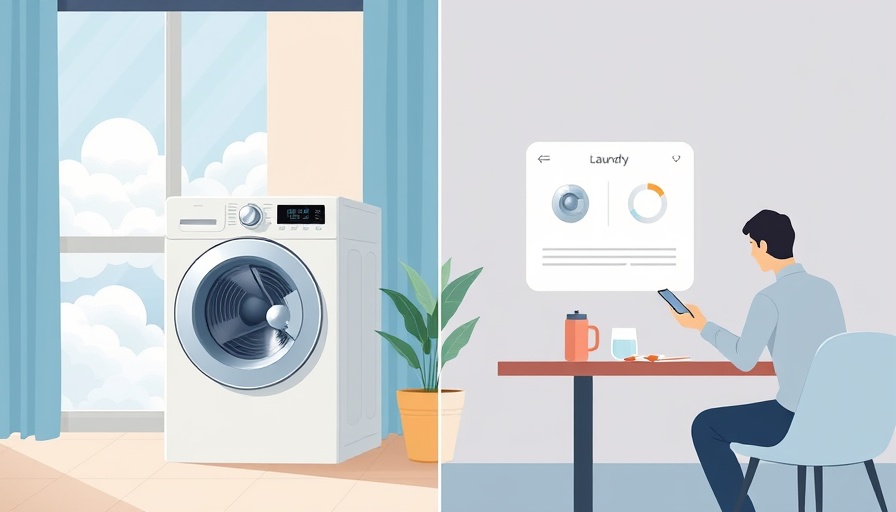
Revamping Historic Elegance: A New Take on a Versailles Apartment
In a bold renovation project, design duo Inès Deschodt and Johanne Le Griffon have mixed modern flair with historical grandeur, transforming a chef's Versailles apartment while adhering to strict building regulations. As environmentally conscious homeowners look to blend sustainability with style, this renovation stands as a beacon of innovative home design intertwined with rich heritage.
Creating a Contemporary Cocoon
The client’s desire for a "cocoon" that hints at the opulent style of the nearby Palace of Versailles sparked a creative challenge. Deschodt and Le Griffon made a conscious effort to avoid clichés of hyper-classicism. Instead, their goal was to weave contemporary design into the existing architectural tapestry. The stark reality of the previous décor — vibrant yellow walls and heavy red tapestries — served as a blank canvas ripe for aesthetic transformation. Through intelligent design choices, they maintained the stunning period moldings while highlighting them as key design features. Such decisions not only celebrated the apartment's history but also set the stage for new, modern aesthetics that resonate with today's environmentally conscious homeowners, keen on reducing excess while embracing style.
Integrating Sustainability in Home Design
As homeowners increasingly focus on sustainability, this renovation embodies how modern practices can align with traditional architecture. By choosing eco-friendly materials and energy-efficient installations, Deschodt and Le Griffon demonstrated that luxury doesn’t necessitate environmental compromise. Using responsibly sourced furnishings and prioritizing efficient energy use, the redesign aligns beautifully with the growing trend toward green living in home construction. For those looking to undertake similar renovations, incorporating sustainable principles from the planning stages can lead to a harmonious blend of style and ecology. Homeowners can also benefit from seeking design professionals adept in marrying modern technology with sustainable practices, ensuring their spaces remain functional while being mindful of environmental impacts.
Functionality Meets Aesthetic Ambition
A successful home should be as functional as it is beautiful. This principle guided Deschodt and Le Griffon in creating a living space ideal for both relaxation and entertaining. The duality of the apartment — with spaces designed for solitude as well as vibrant gatherings — speaks volumes about the future of home design. It's a reflection of modern life, where balance reigns supreme. By thoughtfully selecting furniture that offers versatility—like the contemporary Pacific sofa and the Maison Verrsen armchair—they designed seating arrangements that allow for large gatherings or intimate nights in. These choices echo a larger trend in architecture and building design, where purpose-driven spaces often double as multifunctional areas, crucial for today’s dynamic lifestyles.
Challenges of Renovating Historic Homes
While the project yielded impressive results, the path was not devoid of hurdles. Working on a historic site comes with a unique set of challenges. Adhering to the French authorities' regulations meant that renovations had to respect existing structures while innovating within those confines. This exemplifies the modern home construction narrative — how creativity flourishes within limitations, resulting in designs that tell stories of the past while paving paths toward the future. To effectively manage such restrictions, homeowners and designers alike should consult local historical preservation guidelines early in the planning process. This foresight not only mitigates potential compliance issues but can also inspire innovative methods to unify past and present architectural styles.
Envisioning Future Home Designs
As this project highlights, the future of home design is increasingly focused on the amalgamation of sustainability, style, function, and history. With homeowners leaning toward designs that reflect personal values and ecological consciousness, upcoming trends will likely feature more renovations that celebrate and preserve historical elements while adopting modern sustainability practices. Whether it's through energy-efficient systems or using environmentally friendly materials, the emphasis remains on living compassionately within our spaces. In conclusion, the impressive renovation of the Versailles apartment by Inès Deschodt and Johanne Le Griffon is more than just an aesthetic endeavor. It’s a symbol of what can be achieved when modern ideals intersect with historical sensibilities. For environmentally conscious homeowners aged 35-55, this case study serves as an inspiration to reimagine their own spaces with an eye toward sustainability, innovation, and beautiful design. Embrace the opportunity to rethink your living space by considering how you can incorporate sustainable principles into your own home design. Together, we can create environments that honor their histories while also nurturing our planet.
 Add Row
Add Row  Add
Add 



Write A Comment